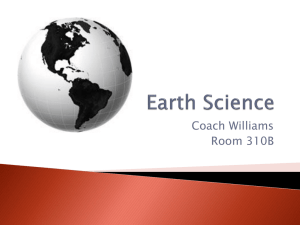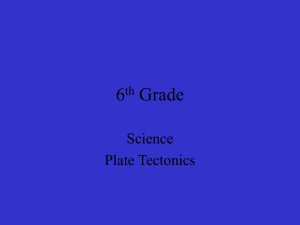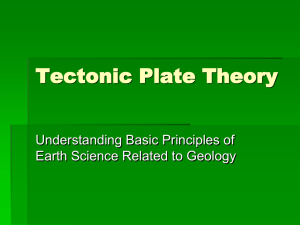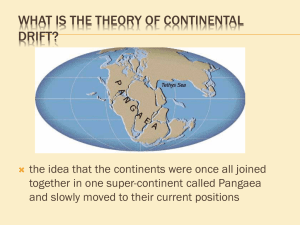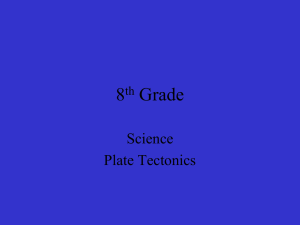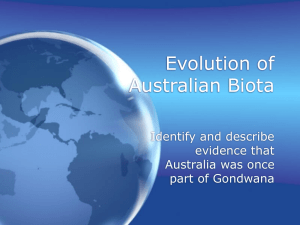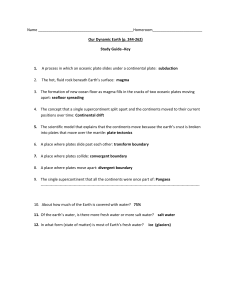Lesson-WS-Answers-for-upload1
advertisement
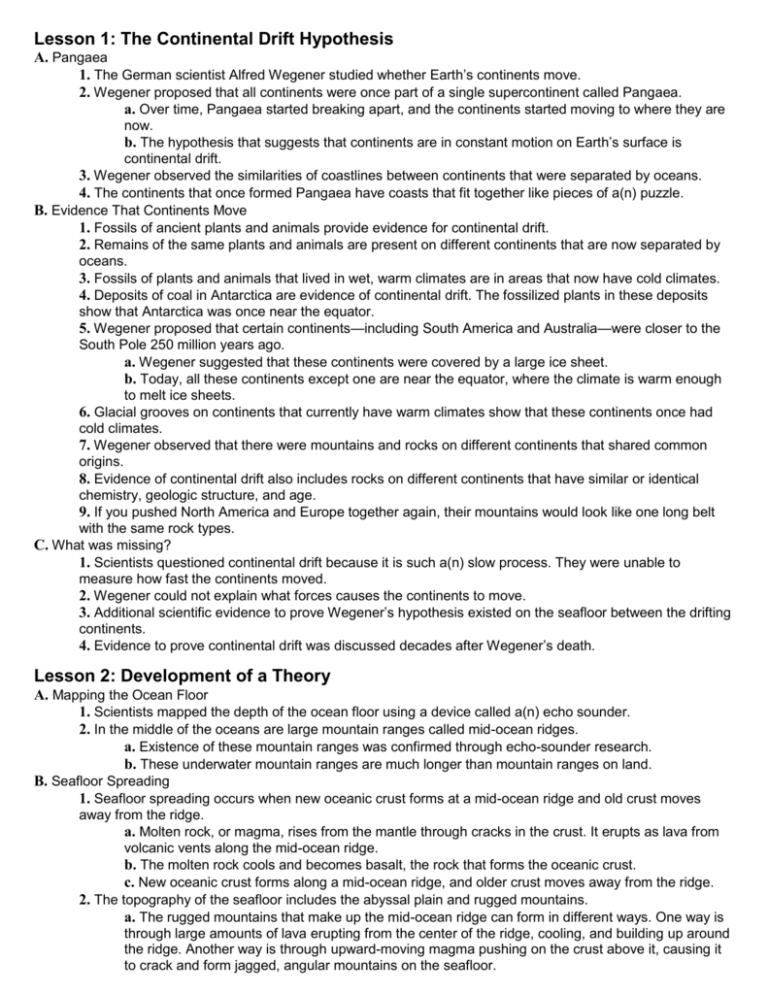
Lesson 1: The Continental Drift Hypothesis A. Pangaea 1. The German scientist Alfred Wegener studied whether Earth’s continents move. 2. Wegener proposed that all continents were once part of a single supercontinent called Pangaea. a. Over time, Pangaea started breaking apart, and the continents started moving to where they are now. b. The hypothesis that suggests that continents are in constant motion on Earth’s surface is continental drift. 3. Wegener observed the similarities of coastlines between continents that were separated by oceans. 4. The continents that once formed Pangaea have coasts that fit together like pieces of a(n) puzzle. B. Evidence That Continents Move 1. Fossils of ancient plants and animals provide evidence for continental drift. 2. Remains of the same plants and animals are present on different continents that are now separated by oceans. 3. Fossils of plants and animals that lived in wet, warm climates are in areas that now have cold climates. 4. Deposits of coal in Antarctica are evidence of continental drift. The fossilized plants in these deposits show that Antarctica was once near the equator. 5. Wegener proposed that certain continents—including South America and Australia—were closer to the South Pole 250 million years ago. a. Wegener suggested that these continents were covered by a large ice sheet. b. Today, all these continents except one are near the equator, where the climate is warm enough to melt ice sheets. 6. Glacial grooves on continents that currently have warm climates show that these continents once had cold climates. 7. Wegener observed that there were mountains and rocks on different continents that shared common origins. 8. Evidence of continental drift also includes rocks on different continents that have similar or identical chemistry, geologic structure, and age. 9. If you pushed North America and Europe together again, their mountains would look like one long belt with the same rock types. C. What was missing? 1. Scientists questioned continental drift because it is such a(n) slow process. They were unable to measure how fast the continents moved. 2. Wegener could not explain what forces causes the continents to move. 3. Additional scientific evidence to prove Wegener’s hypothesis existed on the seafloor between the drifting continents. 4. Evidence to prove continental drift was discussed decades after Wegener’s death. Lesson 2: Development of a Theory A. Mapping the Ocean Floor 1. Scientists mapped the depth of the ocean floor using a device called a(n) echo sounder. 2. In the middle of the oceans are large mountain ranges called mid-ocean ridges. a. Existence of these mountain ranges was confirmed through echo-sounder research. b. These underwater mountain ranges are much longer than mountain ranges on land. B. Seafloor Spreading 1. Seafloor spreading occurs when new oceanic crust forms at a mid-ocean ridge and old crust moves away from the ridge. a. Molten rock, or magma, rises from the mantle through cracks in the crust. It erupts as lava from volcanic vents along the mid-ocean ridge. b. The molten rock cools and becomes basalt, the rock that forms the oceanic crust. c. New oceanic crust forms along a mid-ocean ridge, and older crust moves away from the ridge. 2. The topography of the seafloor includes the abyssal plain and rugged mountains. a. The rugged mountains that make up the mid-ocean ridge can form in different ways. One way is through large amounts of lava erupting from the center of the ridge, cooling, and building up around the ridge. Another way is through upward-moving magma pushing on the crust above it, causing it to crack and form jagged, angular mountains on the seafloor. b. Eventually, sediment forms on top of the oldest oceanic crust, making a smooth seafloor called the abyssal plain. 3. Seafloor spreading helps explain continental drift because it shows that continents move with the oceanic crust as it spreads away from mid-ocean ridges. C. Development of a Theory 1. Evidence to support seafloor spreading first came from studying the magnetism of rocks on the seafloor. 2. Earth’s outer core causes Earth’s magnetic field. a. The direction of Earth’s magnetic field reverses often. b. When a magnetic field causes a magnet to point north, the magnetic field has normal polarity. c. A magnetic field reverses direction during a(n) magnetic reversal. d. After a magnetic reversal, a magnet points south because Earth’s magnetic field has reversed polarity. 3. Magnetic signatures form when iron-rich minerals in cooling lava align with the direction of Earth’s magnetic field. a. The direction of a magnetic field in minerals can be determined by using a device called a(n) magnetometer. b. Magnetometers show parallel magnetic stripes on either side of a mid-ocean ridge. c. These stripes alternate normal polarity and reversed polarity, showing that each stripe was formed at the mid-ocean ridge and then moved away. 4. Sediment collected from the seafloor show that sediment farther away from a mid-ocean ridge is older than the sediment that is closer to the ridge. Lesson 3: The Theory of Plate Tectonics A. The Plate Tectonics Theory 1. The theory of plate tectonics states that Earth’s surface is divided into rigid plates of rock. Each plate moves over Earth’s mantle and changes position with respect to other plates. a. The word tectonic describes the forces that shape Earth’s surface and rock structures that form as a result. b. Of all Earth’s tectonic plates, the Pacific Plate is the largest. 2. The cold, rigid rock layer on the outermost part of Earth is called the lithosphere. It consists of crust and the upper part of the mantle. 3. Below the lithosphere is the asthenosphere, which is so hot that it flows like plastic. 4. Plates of lithosphere move because they rest on the flowing asthenosphere. B. Plate Boundaries 1. The place where two plates meet is called a(n) plate boundary. 2. When two plates move away from each other, a(n) divergent plate boundary forms. a. In the ocean, mid-ocean ridges are located at divergent plate boundaries. b. If divergent plate boundaries separate parts of a continent, rift valleys form. 3. When two plates slide by each other, a(n) transform plate boundary forms. This type of movement causes earthquakes. 4. When two plates collide, a(n) convergent plate boundary forms. a. When plates collide, the plate that is denser slides under the less-dense plate in the process of subduction. b. When an oceanic plate slides under a continental plate, a deep ocean trench forms. Near the trench, a line of volcanoes forms. c. When two oceanic plates collide, a trench and a(n) island arc form. d. When two continental plates collide, neither plate is subducted, and mountains form. C. Evidence for Plate Tectonics 1. Scientists now use satellites to help measure how continents move. 2. The theory of plate tectonics explains why earthquakes and volcanoes occur in certain locations. D. Plate Motion 1. Earth’s mantle moves because warmer, less-dense materials rise, and cooler, denser materials sink. a. Materials move based on differences in their temperatures and densities in the process of convection. b. Inside Earth, radioactive elements provide some of the thermal energy that causes convection. c. Convection currents form in the mantle when thermal energy transfers from the core to the mantle. 2. Three forces interact to cause tectonic plate motion. a. Convection currents in the mantle produce a force that causes motion called basal drag. b. Plates are pushed away from each other at mid-ocean ridges by the force of ridge push. c. When a plate sinks below another plate, it pulls on the rest of the plate, exerting a force called slab pull. E. A Theory in Progress 1. Plate tectonics is the unifying theory of geology. 2. Plate tectonics theory is still being revised as scientists learn more about how Earth’s tectonic plates move. Content Practice A (page 13) 1. a supercontinent that included all the continents as one landmass 2. the idea that the continents are in constant motion on the surface of Earth Content Practice B (page 14) 1. Alfred Wegener proposed that at one time all the continents were part of one large landmass. 2. Wegener suggested that over time Pangaea began to break apart and that the continents slowly moved apart to where they are today. 3. Scientists have discovered fossils of similar plants and animals on continents that are now separated by oceans. 4. Coal, which is made from fossilized plants, is present in polar regions. Glacial grooves caused by ice moving across rock are present in climates that are too warm for ice sheets, such as those that cover Antarctica today. 5. Mountain ranges and rock formations that have common origins are on different continents. 6. They would form one continuous mountain range. School to Home (page 15) 1. Millions of years ago, all of today’s continents were united in one supercontinent called Pangaea. Pangaea broke apart, forming separate continents that drifted to today’s locations. 2. Usually the fossils on different continents are very different. However, there are fossils of the same fern on five different continents. This leads people to think that these five continents were close to each other long ago. 3. Coal is the fossilized remains of plant life in warm, wet climates. For coal to be present in Antarctica, its climate must have been warmer in the past. 4. The mountains have rocks that are similar and about the same age. The mountains look as though they fit together and could form one long mountain range. Key Concept Builder (page 17) 1. coastlines 2. continents 3. Pangaea 4. continental drift 5. fossils 6. climate 7. warm 8. South Pole 9. ice sheet 10. rock 11. geologic 12. Caledonian 13. Appalachian 14. puzzle Key Concept Builder (page 18) 1. a few centimeters 2–3. (in any order) Fossils of different organisms (or plants) are on continents that are now separated by oceans. 4. Plants and animals had to live on landmasses that were once connected but are now separate continents. 5. Coal, made of fossilized plants that lived in warm, wet climates, is present in Antarctica. 6. The continent of Antarctica must have been warmer and wetter long ago. 7. Glacial grooves are present on continents close to the equator. 8. South America, Africa, India, and Australia were located near the South Pole 250 mya and covered with a large ice sheet, similar to the one that covers Antarctica today. 9. Mountain ranges and rock formations on different continents likely have common origins. 10. The continents must have been part of one landmass long ago. Key Concept Builder (page 19) For the completed table, see page T17. 1. Possible answer: Wegener spent many years studying the clues that supported his hypothesis. Although he could not prove that continental drift actually occurred, his clues were strong enough for him to believe he was correct. 2. Possible answer: I think fossil clues are most convincing because it would have been impossible for most animals to move to continents across large oceans unless the continents were connected at the time. 3. Possible answer: The fact that I think is the most interesting is that mountain ranges on different continents are similar in origin and fit together like a puzzle. I think that fact is interesting because it is evidence that they moved apart. Content Practice B (page 31) 1. Mid-ocean ridges 2. Gravity 3. Normal, reversed 4. cools 5. stripes 6. spreading 7. Continents Key Concept Builder (page 33) 1. It becomes lava and cools to form rock. 2. pillow lavas 3. at the mid-ocean ridge 4. It moves away from the mid-ocean ridge. 5. Magma that rises through cracks on the seafloor erupts and becomes lava. The lava cools rapidly in the ocean, forming rock structures. This new rock is located at the mid-ocean ridges. Older rock is carried away as the seafloor spreads. Key Concept Builder (page 34) 1. lava that cools and solidifies 2. basalt 3. The new oceanic crust pushes the old oceanic crust away from the mid-ocean ridge. 4. It becomes denser. 5. away from the mid-ocean ridge 6. gravity 7. sediment 8. far away from the mid-ocean ridge 9. a smooth plain 10. abyssal plains 11. spreading 12. continents move 13. the direction of Earth’s magnetic field 14. iron-rich minerals 15. magnetic stripes 16. Ocean crust is made at mid-ocean ridges and is carried away from the ridges. Key Concept Builder (page 35) 1. flat 2. along the seafloor 3. in the middle of the oceans 4. than any on land 5. on either side of the mid-ocean ridge 6. a magnetic signature 7. crust formed at different times 8. at the mid-ocean ridges 9. from beneath abyssal plains 10. younger Key Concept Builder (page 36) 1. Normal polarity means magnets will orient themselves to point north. 2. Reversed polarity means magnets reverse direction and orient themselves to point south. 3. Minerals record a different magnetic signature. 4. Magnetic reversals occur anywhere from a few hundred thousand years to a few million years. 5. Ocean crust is made at mid-ocean ridges and is carried away from the ridges. 6. They show that the crust is moving and that the seafloor is spreading. Content Vocabulary (page 45) 1. plastic 2. convergent plate boundary 3. divergent plate boundary 4. transform plate boundary 5. subduction 6. ridge push 7. slab pull 8. plate tectonics 9. lithosphere 10. convection Content Practice A (page 49) 1. Possible answer: A divergent plate boundary is where two of Earth’s tectonic plates separate, such as at a mid-ocean ridge. 2. Student drawings should show two plates and have arrows indicating that the plates are pulling in opposite directions. 3. Possible answer: A transform plate boundary is where two of Earth’s tectonic plates slide by each other. 4. Student drawings should show two plates and have arrows indicating that one plate is sliding past the other. 5. Possible answer: A convergent plate boundary is where two of Earth’s tectonic plates collide. 6. Student drawings should indicate two plates colliding—one sliding under the other or one folding to become mountains. Math Skills (page 53) 1. 17.5 cm 2. 30 cm 3. 80 mm 4. 15 yr School to Home (page 54) 1. The lithosphere is thin beneath mid-ocean ridges and thick below continents. 2. Tectonic plates are large pieces of lithosphere. The asthenosphere is flexible like a plastic material. This enables Earth’s tectonic plates to move because the hotter, plastic mantle beneath them can flow. The interactions between these layers helps explain plate tectonics. 3. Divergent plate boundaries occur where two plates separate. Transform plate boundaries occur where two plates slide by each other. Convergent plate boundaries occur where two plates collide. 4. Convection currents in the mantle produce a force that causes motion called basal drag. Ridge push is the force of plates moving away from mid-ocean ridges. Slab pull is the force that pulls on a plate as one edge of the plate sinks into the mantle. Key Concept Builder (page 55) 1. earthquakes and volcanoes 2. where plates meet 3. the rapid release of energy when plates separate, collide, or slide past each other long a plate boundary 4. the separation or collision of plates 5. the collision of continental plates 6. Two plates slide past each other, causing earthquakes. 7. Volcanoes are located where two plates separate. 8. plate boundaries Key Concept Builder (page 56) 1. a place where two rigid plates of rock meet 2. where two plates separate 3. where two plates collide Key Concept Builder (page 58) 1–3. (in any order) basal drag, ridge push, slab pull 4. It loses its heat to the cold surface above. 5. Convection currents form. 6. Three Earth forces interact to move the plate. 7. The currents cause the asthenosphere to drag the lithosphere. 8. The rising mantle of ocean ridges creates a force called ridge push. 9. It creates a force called slab pull that drags the rest of the force downward. 10. One plate sinks into the mantle along a subduction zone.

